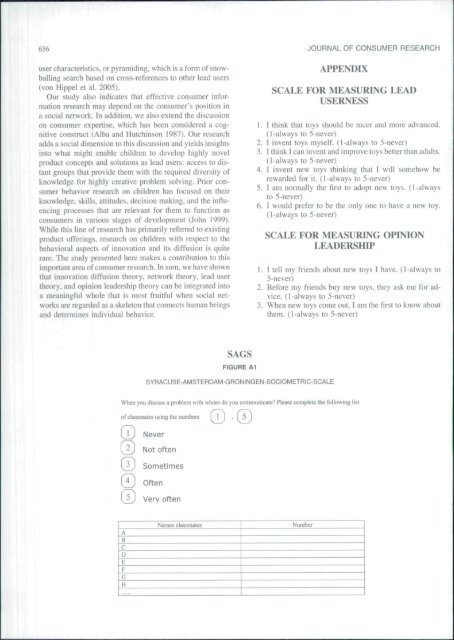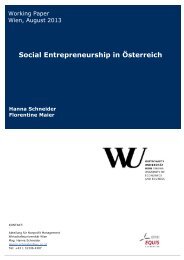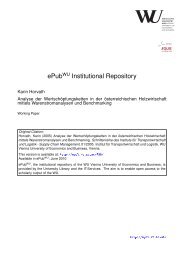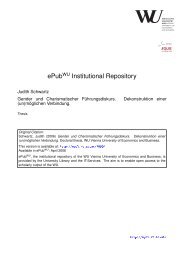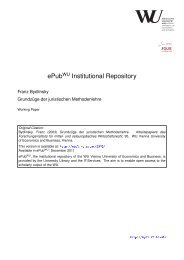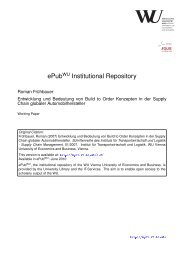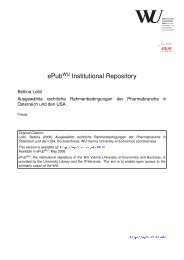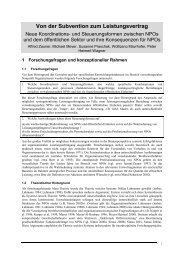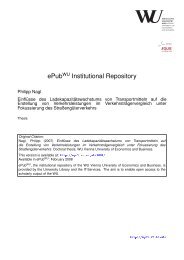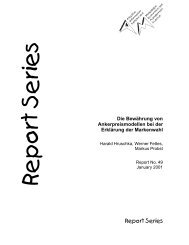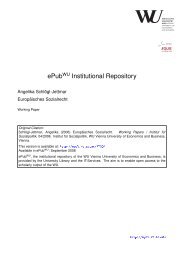Download - ePub WU
Download - ePub WU
Download - ePub WU
You also want an ePaper? Increase the reach of your titles
YUMPU automatically turns print PDFs into web optimized ePapers that Google loves.
656<br />
user cbaracteristics, or pyramiding, which is a form of snowballing<br />
search based on cross-references to other lead users<br />
(von Hippel et al. 2005).<br />
Our study also indicates that effective consumer information<br />
researcb may depend on tbe consumer's position in<br />
a social network. In addition, we also extend the discussion<br />
on consumer expertise, which has been considered a cognitive<br />
construct (Alba and Hutchinson 1987). Our research<br />
adds a social dimension to this discussion and yields insights<br />
into what might enable cbildren to develop highly novel<br />
product concepts and solutions as lead users: access to distant<br />
groups that provide them with the required diversity of<br />
knowledge for highly creative problem solving. Prior consumer<br />
bebavior research on cbildren has focused on their<br />
knowledge, skills, attitudes, decision making, and tbe influencing<br />
processes that are relevant for them to function as<br />
consumers in various stages of development (John 1999).<br />
While this line of research has primarily referred to existing<br />
product offerings, research on children witb respect to the<br />
behavioral aspects of innovation and its diffusion is quite<br />
rare. Tbe study presented here makes a contribution to this<br />
important area of consumer research. In sum, we have shown<br />
that innovation diffusion theory, network theory, lead user<br />
theory, and opinion leadership theory can be integrated into<br />
a meaningful whole that is most fruitful wben social networks<br />
are regarded as a skeleton that connects human beings<br />
and determines individual bebavior.<br />
JOURNAL OF CONSUMER RESEARCH<br />
APPENDIX<br />
SCALE FOR MEASURING LEAD<br />
USERNESS<br />
1. I think tbat toys sbould be nicer and more advanced.<br />
(I-always to 5-never)<br />
2. I invent toys myself. (1-always to 5-never)<br />
3. I tbink 1 can invent and improve toys better than adults.<br />
(1-always to 5-never)<br />
4. I invent new toys tbinking that I will somehow be<br />
rewarded for it. (1-always to 5-never)<br />
5. J am normally tbe first to adopt new toys. (1-always<br />
to 5-never)<br />
6. I would prefer to be tbe only one to have a new toy.<br />
(1-always to 5-never)<br />
SCALE FOR MEASURING OPINION<br />
LEADERSHIP<br />
1. I tell my friends about new toys 1 have. (1-aIways to<br />
5-never)<br />
2. Before my friends buy new toys, tbey ask me for advice.<br />
(1-always to 5-never)<br />
3. When new toys come out. I am tbe first to know about<br />
them. (1-always to 5-never)<br />
SAGS<br />
FIGURE Al<br />
SYRACUSE-AMSTERDAM-GRONINGEN-SOCIOMETRIC-SCALE<br />
When you discuss a problem with whom do you coramunicaic? Please complete the following list<br />
ofclassmates using the numbers I 1 I 15<br />
Never<br />
Not often<br />
Sometimes<br />
Often<br />
Very often<br />
Names classmates<br />
Number<br />
A<br />
B<br />
C<br />
D<br />
E<br />
F<br />
G<br />
H


